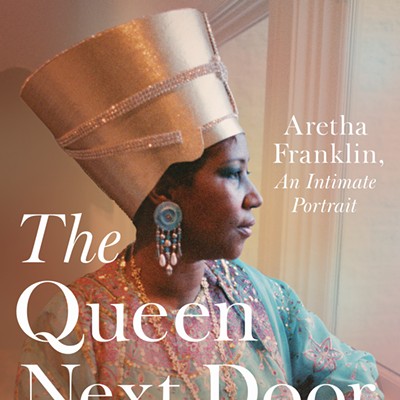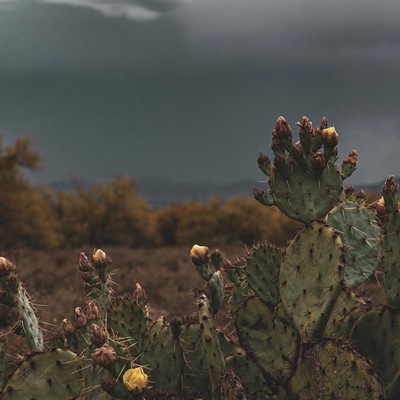Now on view in a three-person show at Pima Community College West, Rosenthal's images are deliberately blurry, like fragments of a dream. Children emerge out of darkness. Strange and unexpected terrors turn up, like a bear on a staircase or a giant bug in the dirt. Sweet-faced tots wear the wings of angels or the horns of the devil.
The pier by a lake is sunny "A Dream Half Remembered #FHF-53-10," but it's crisscrossed by shadows. A murky pine forest rises up beyond a small child standing alone near the deep water. "A Dream Half Remembered #FPT-46-5" pictures a little girl on a suburban lawn that's ringed by wintry trees and a classic white picket fence. But these emblems of the good life are faded, and their outlines merge into a pale sky. The child herself throws back her head and gazes upward, her mind far away from her surroundings.
The pictures, Rosenthal explains in an artist's statement posted in the Louis Carlos Bernal Gallery, have the "random structure and narrative of dreams." Like elusive childhood memories, these photos are ambiguous, their stories uncertain. Colored the old-time sepia of faded family snapshots, these split-toned gelatin silver prints sometimes have a touch of pale pink or blue. They've been stripped of detail and specificity, Rosenthal notes, so they'll be "more universal." They may be about his own childhood, or his daughters', but they also touch on everyone else's.
A particularly dark image of a staircase conjures up a classic kid's nightmare: getting trapped in a basement. The camera in "SSO-1244-2" is positioned from a child's-eye view at the bottom of the steps; the staircase looms above, nearly invisible in the dark. A few steps are dimly lit, and at the top of the stairs, where salvation awaits, a light glows faintly. But the journey from the darkness below to the light above feels impossible.
A staircase also figures prominently in that nightmare photo of the bear ("BOS-17/18"). A light illuminates the walls, but the steps themselves are charcoal-going-to-black. The shadowy bear rears up on its hind legs on the landing. What child hasn't imagined such a beast in the night, blocking the way to safety?
Even the more idyllic photos of children on the dock at a lake have an undercurrent of tension. Though he grew up along the water in California and by a lake in northeast Washington, where his family had a cabin, the photographer's feelings about water are mixed. In an interview last year, Rosenthal revealed that he had nearly drowned during a swimming lesson at a preschool.
His ambivalence about water comes through in a picture like "#FFJ-47-5/6." It dreamily pictures another child on a lake dock, with the northern trees behind her. She's apparently clutching a cat. This one is so indistinct, it's hard to see, and it's just as difficult to know what's going to happen. Perhaps it's just a glimpse of a half-remembered happy summer day; perhaps it's the prelude to disaster.
A lovely, bright picture of a child in a tub is more benign ("FB-41-1"). The clean walls of the bathroom provide an angular architectural framework for the curve of the child's body and her small portable tub. Beatific light flows in through the window, illuminating her skin and her dark, wet hair. Viewed from the back, she's posed placidly, and she's joyfully in possession of her space.
Rosenthal's mesmerizing images have been winning him attention around the country of late. A regular at Tucson's Etherton Gallery, he's showing this same series right now in the Michael Dawson Gallery in Los Angeles, and earlier this fall, he exhibited them in Houston. He was in a group show at the George Eastman House in Rochester. But he still works as an adjunct art professor at Pima, a day (or night) job that links him with the two other artists in the show.
Travis Glaab, a fine painter who teaches at the new northwest Pima campus, also delves into childhood imagery. In his case, though, the strange figures with big heads and crooked mouths etched into his oils are the handiwork of his young daughter. This father-daughter collaboration, pairing a skilled artist with a naïve one, makes for a couple of interesting, uneasy works.
In "Conversation: Too Much Audience," a small, vertical oil on canvas, Glaab painted a dappled background in forest shades, veering from earth green to deep green. A deft painter, he typically swabs a wide brush onto the canvas with vigorous, visible strokes. For this work, his little girl added an eerie element in the upper-right corner. Her two figures, etched into the thick, wet paint, are drawn in that familiar kindergarten style that hints at universal archetypes.
Her figures' straight up-and-down bodies are hunched together, their giant hands bobbing against each other. They look like primitive sages, wise messengers from some Jungian unconscious.
Elsewhere, Glaab, on his own, paints sturdy objects into skillfully layered planes of color. These fine, small paintings are sort of still lives and sort of not: The objects look familiar, but not quite, like stuff whose elusive names are just at the tip of your tongue.
"Conversation: Resolved" pictures what look almost like a pair of child's rubber boots. But they're not. They're simple cylindrical tubes, painted a lush green, and topped by a rich black. A background vaguely suggests an interior space, with a diagonal line separating a "wall" layered in pale blue, gold and white, and a "floor" that's a golden tan. Likewise, "The Loss: Dream Sequence" is a beautifully painted layering of blue-green and burnt orange, with another strange cylindrical object at the center. They may be stripped of discernible meaning, but lined up together on the wall, these striking paintings look almost like church icons.
The third Pima professor in the show, Valerie Constantino, specializes in mixed-media collage. Her tiny works combine pieces of fine silk with slick magazine photos and cut paper. The "Firefighter Series" is a trio of eccentric Sonoran Desert landscapes. A photo of saguaros dominates the foreground in one, while white silk painted with flashes of gold stands in for the clouds, and a piece of gray paper is the sky.
Her themes fit right in with those of her colleagues. Rosenthal and Glaab may use photographs and paintings to explore dream states and the unconscious, but for Constantino, it's collage and assemblage, as she says in her artist's statement, that mimic the "random juxtapositions of our everyday lives."














